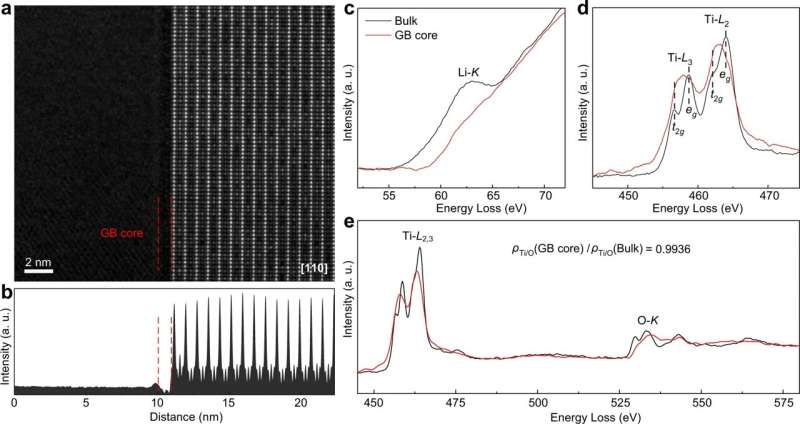
A research team led by Prof. Ma Cheng from the University of Science and Technology of China (USTC) of the Chinese Academy of Sciences (CAS) revealed that the large resistance in Li-ion-conducting electrolyte is not caused by space-charge layers, contrary to what was believed in the past decades.
Compared with commercial lithium-ion batteries that adopt liquid electrolytes, all-solid-state lithium batteries are much safer and more promising in realizing ideal energy density. In an all-solid-state Li battery, space charge layers are generated near various solid-solid interfaces, which was previously believed to lead to large interfacial resistance: the space charge layers form regions of extremely low concentration of Li ions near the grain boundary, which limits ion migration efficiency.
To gain a thorough understanding of the actual effect of space charge layers on ion transport, the team conducted direct observations of the material at the atomic scale using atomic-resolution high angle annular dark-field (HAADF) scanning transmission electron microscopy (STEM).
Surprisingly, researchers discovered that the concentration of Li ions near the grain boundaries was higher than the average level. They pinpointed the location of these excess Li ions in the lattice. Then, researchers combined theoretical calculations and electrochemical tests, and found that this crystal structure enabled quite efficient ion transport, contrary to the commonly accepted hypothesis.
This finding not only clarifies the role that space-charge layers play, but also provides a guiding law for the optimization of the interface of all-solid-state batteries. The information on the detailed atomic structures near the grain boundary is also essential for understanding the physical properties of solid electrolytes.
The paper is published in the journal Nature Communications.
More information:
Zhenqi Gu et al, Atomic-scale study clarifying the role of space-charge layers in a Li-ion-conducting solid electrolyte, Nature Communications (2023). DOI: 10.1038/s41467-023-37313-2
Citation:
Space-charge layers of Li-ion-conducting solid electrolyte shown to not cause large resistance (2023, April 12)
retrieved 12 April 2023
from https://techxplore.com/news/2023-04-space-charge-layers-li-ion-conducting-solid-electrolyte.html
This document is subject to copyright. Apart from any fair dealing for the purpose of private study or research, no
part may be reproduced without the written permission. The content is provided for information purposes only.
For all the latest Technology News Click Here
For the latest news and updates, follow us on Google News.
